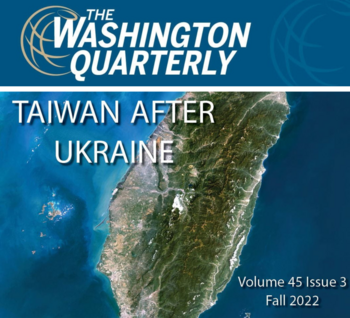Will this approach be sufficient, however? Conflicting trends in Korea’s domestic public opinion complicate the picture. On the one hand, anti-China sentiment is worsening by the day, even surpassing anti-Japan sentiment. At the same time, there are also growing complaints about the United States, especially after the exclusion of consumer tax credits for Korea’s electric vehicles in the Inflation Reduction Act (IRA). Taking these developments into account, this essay seeks to explore the path ahead for Korea by analyzing the nature of U.S.-China tensions and assessing the durability of Pax Americana.
Heading into Thucydides Trap?
U.S.-China relations are widely characterized as “Thucydides Trap.” The Peloponnesian War is regarded as one of the main reasons behind the decline of ancient Greek civilization. Thucydides, an Athenian general and historian, famously wrote that the fundamental cause of this war was due to Spartan fears over the growth of Athenian power. Drawing from Thucydides, international relations theorists have used the concept of a Thucydides Trap to explain tensions between a rising power and a status quo hegemon. Graham Allison, a professor of political science at Harvard, popularized this concept by applying it to Sino-U.S. relations in Destined for War. Beginning from the clash between Portugal and Spain in the late 15th century, Allison notes that there have been 16 instances where an emerging power challenged the hegemonic power. There was a war in all but four cases. When an emerging power is strong enough to challenge the hegemon, this creates structural stresses that frequently lead to a violent conflict.
Based on his analysis of the historical record, Allison warns that the rift between the United States (America First) and China (the Chinese dream) is much wider and deeper than most people perceive it to be. There is now a heightened risk of an armed confrontation between the two countries over Taiwan. Nevertheless, the likelihood of a catastrophic hegemonic war still remains low. Instead, there is likely to be a prolonged conflict and competition between Washington and Beijing centered on advanced technologies.
Made in China 2025 and the Chinese Dream
The U.S.-China trade war began under the Trump administration. Made in China 2025 (MIC 2025), a policy roadmap published by the Chinese government in 2015, drew the attention of the United States and other Western countries. In its opening paragraph, it states that “building an internationally competitive manufacturing industry is the only way China can enhance its comprehensive national strength, ensure national security, and build itself into a world power.”[6]
From the emphasis on “the only way,” it is clear that MIC 2025 is not just an industrial policy. It is an integral element of China’s national security strategy. Under this plan, China seeks to achieve progress in advanced manufacturing technologies such as big data, information technology, aerospace, artificial intelligence, and biotechnology. The goal is to become the world’s leading manufacturing power by surpassing the United States.
After MIC 2025 sparked controversy in the West, the Chinese government has refrained from referring to it in public. Nonetheless, it has continued to implement this policy in practice. At the 2021 Lianghui, the concurrent annual meetings of the National People’s Congress and the Chinese People’s Political and Consultative Conference, the Chinese government strengthened its resolve to reduce its dependence on U.S.-led global value chains as it sought to develop advanced technologies. Specifically, it emphasized the economic policy of dual circulation, which aims to raise domestic consumption while expanding exports of high value-added goods to foreign markets.
The advanced technologies that China is focusing on have potential military applications. For example, drones, artificial intelligence, and facial recognition technology can be used for reconnaissance satellites and unmanned aerial vehicles. China is pursuing military-civil fusion through the Military-Civil Fusion Development Committee, chaired by President Xi. This indicates that Xi intends to personally oversee China’s ambitious efforts to challenge the United States. At this year’s Lianghui, Xi stressed that China is in a strategically advantageous position in its deepening competition with the United States. Furthermore, he unveiled a plan to achieve his “dream of a strong military” by modernizing China’s armed forces through mechanization and the use of advanced information technology. Despite a slowdown in China’s economy, Xi increased defense spending by 7.1 percent.[7]
Those who analyze Xi Jinping’s character classify him as an ideological purist, a true believer of socialism. He sees a historic opportunity for China to become a global superpower, and believes that it is his calling to realize socialism in the 21st century. Unlike his predecessors, he does not shy away from conflict with the United States. In a September 30, 2022, essay in Qiushi, the Chinese Communist Party’s (CCP) leading theoretical journal, Xi stated that “today, we have never been so close to achieving the great rejuvenation of the Chinese nation, and we have never been more confident in our faith and ability to achieve this goal.”[8] Only two weeks before the CCP’s 20th party congress, where he would secure a third term as general secretary, Xi stressed the need for strong leadership to prepare for the intensifying competition with the United States.
Under Xi’s leadership, the CCP is driven by the zeitgeist of the Chinese dream, of realizing the great rejuvenation of the Chinese nation. The goal is to make the People’s Republic of China (PRC) the most powerful economic and military power in the world. The emphasis on achieving this goal by 2049 is no coincidence, as it will mark the centennial of the CCP’s victory in the Chinese Civil War, where it defeated the Kuomintang and established the PRC. This timeline also aligns with Xi’s vision of building an advanced socialist country by 2050, which he proclaimed at the 19th National Congress of the CCP. China has a truly ambitious vision, one that leaves the United States no choice but to respond.
From America First to Made in America
When Donald Trump proclaimed “America First” as his slogan in his bid for the White House, his primary target was China. He blamed China for the loss of American jobs, claiming that the United States was suffering greatly from China’s unfair trade practices and interference in markets. This message bolstered his support among white blue-collar workers in the Rust Belt, as they had witnessed a dramatic decline in manufacturing jobs. This enabled him to win key swing states in the Midwest, leading to his victory in the 2016 election.
Upon entering office, Trump consistently maintained a hardline policy against China. For example, the “Secure 5G and Beyond Act of 2020” passed the House 413–3 and cleared the Senate on March 6, 2020. The intent of this law was to create a “whole-of-government approach” to protect America’s telecommunications networks from national security threats posed by Chinese companies such as Huawei and ZTE, which played a major role in the rollout of 5G networks across the world.[9] His administration increased government oversight of Chinese investment in or acquisition of U.S. tech companies and scrutinized partnerships between American universities and Chinese entities. It tightened visa review procedures for students and visiting scholars from the PRC. It also designated Confucius Institutes in the United States as a “foreign mission” that “[advances] Beijing’s global propaganda and malign influence campaign on U.S. campuses and K-12 classrooms.”[10] All of these measures stemmed from a recognition that China was rapidly closing in on the United States. The National Intelligence Council estimates that if current trends continue, China will surpass the United States to become the world’s largest economy between 2030 and 2035.
The American public’s view of China has continued to deteriorate after Trump left office. According to Pew Research, 47% of respondents held a negative view of China in 2018. This surged to 60% in 2019 and 82% in 2022.[11] Despite a transfer of power to the Democrats in 2020, the overall orientation of U.S. policy toward China has remained unchanged. Under the banner of “Made in America,” the Biden administration has carefully crafted a dense web of policies aimed at China.
In the past three months alone, there have been a raft of legislative and executive measures that encompass semiconductors, electric cars and batteries, and biotechnology. This includes the CHIPS and Science Act (August 9), the IRA (August 16), and an Executive Order on Advancing Biotechnology and Biomanufacturing Innovation (September 12). These steps are intended to check China’s rise and promote the growth of America’s advanced technology and clean energy sectors. The CHIPS and Science Act sets aside $52.7 billion dollars for America’s semiconductor industry.[12] Companies that receive subsidies under this law are barred from expanding operations or otherwise investing in China for the purpose of manufacturing advanced semiconductors.[13] As noted below, certain provisions of the IRA will also have significant ramifications for Korea’s exports of electric cars to the U.S. market.
















